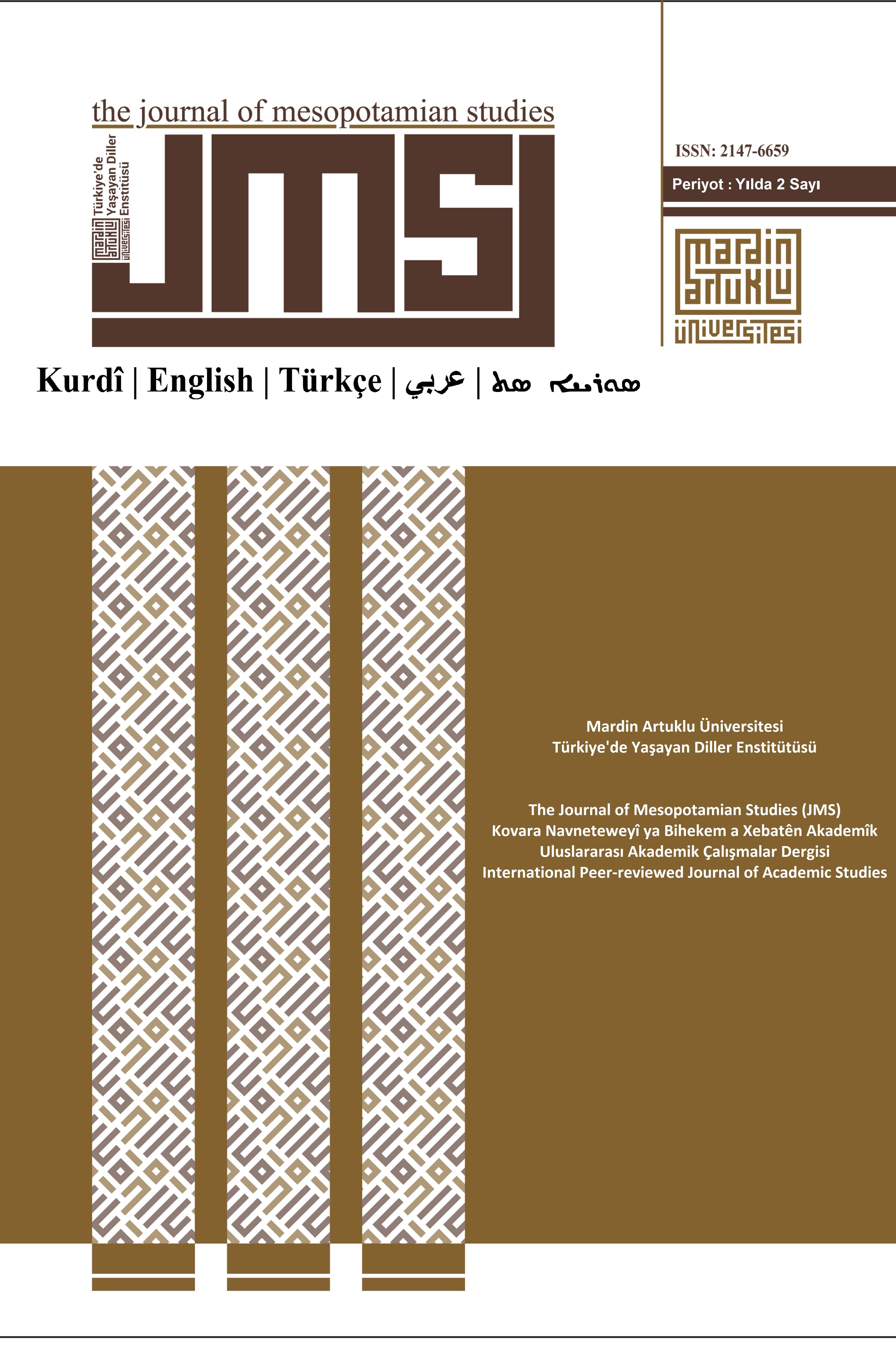Taybetîyên Lehengên Tradîsyonel dî Vegotina Kurdî de
Gelo vegotinên ku bi salan e di nav civata kurdan de tên vegêran û kodên civakî dihewînin xwedî lehengên çawa ne, lehengên wan ji kîjan aliyan ve dişibine hev û ji kîjan aliyan ve ji hev cuda dibin, taybetiyên tîpîk ên lehengên wan çi ne? Ji bo ku em bikaribin bersiva van pirsan bidin û her wiha binyada lehengên tradîsyonel ên kurdî derxin holê, me di vê lêkolînê de hewl da ku li gorî rêbaza Lord Raglan a bi navê “The Hero of Tradition”ê (Lehengê Tradîsyonel) lehengên tradîsyonel ên vegotinên kurdî dahûrînin û taybetiyên wan ên hevpar biselimînin. Ji bo vê jî em di serî de bi giştî li ser hin teoriyên lehangan û bi taybetî jî li ser teoriya Raglan rawestiyan û derbarê lehengan de me agahî dan. Dûvre me vegotinên kurdî li gorî rêbaza Raglan dahûrandin û herî dawî jî li gorî xwendin û selimandinên xwe ji bo lehengên tradisyonel ên Kurdî taybetiyên sereke pêşniyaz kirin.Dahûrîna me li ser van heşt leheng/vegotinên belav e: Xanê Çengzêrîn, Zembîlfiroş, Memê Alan, Ferxik, Cembelî, Dewrêşê Evdî, Kulik û Siyabend.
Anahtar Kelimeler:
Leheng, tradîsyon, Lord Raglan, vegotin
Features of the Traditional Heroes in Kurdish Narration
The narratives that are narrated in Kurdish society for years and contain the codes of society, have what kind of heroes, from which angles are they similar to each other and from which angles are they separated from each other? We aimed to analyze the traditional heroes of the Kurdish narratives according to the method of Lord Raglan's "The Hero of Tradition" in this article in order to be able to answer these questions and thus reveal the structure of traditional Kurdish narrative heroes. For this reason, we have generally discussed some hero theories, especially Raglan's theory, and gave information about the heroes. Afterwards we examined the Kurdish heroes according to Raglan and finally offered the typical features for traditional Kurdish heroes in the direction of our own readings and determinations. Our analysis is about eight common heroes/narratives: Xanê Çengzêrîn, Zembilfiroş, Memê Alan, Ferxik, Cembeli, Dewrêşê Evdî, Kulik and Siyabend
Keywords:
Hero typical, tradition, Lord Raglan, narration,
___
- Campbell, Joseph, The Hero With a Thousands Faces, Princeton University Press, New Jersey, 2004
- Campbel, Joseph, û Moyers, Bill, Mitolojinin Gücü- Kutsal Kitaplardan Hollywood Filmlerine Mitoloji Ve Hikayeler. Zeynep Yaman (wer), Media Cat, İstanbul, 2007.
- Celîl, Celîlê, Celîl, Ordîxanê, Destanên Kurdî, Weşanên Zel, Stenbol, 1994.
- Celîl, Celîlê, Celîl, Ordîxanê, Zargotina Kurda, c. 2, Înstîtuta Kurdzanîyê, Wien, 2014.
- Filiz, Mehmet Şirin, Xebatek li ser Derwêşê Evdî, Teza Mastirê, Zaningeha Mardîn Artukluyê Şaxa Makezanista Çand û Zimanê Kurdî, Mêrdîn, 2014
- Forde, Daryll, Lord Raglan: 1885-1964, Man, h, 64, 1964, r. 181-182
- Nutt, Alfred, “The Aryan Expulsion-and-Return-Formula in the Folk and Hero Tales of the Celts”, The Folk-Lore Record, h. 4, 1881, r. 1-44.
- Oğuz, Mehmet Öcal, Lord Raglan’ın Geleneksel Kahraman Kalıbı ve Basat. Milli Folklor, h. 41, 1999, r. 2-6
- Raglan, Lord, “The Hero of Traditional”, Folklore, h. 3, 1934, r. 212-231.
- Rank, Otto, The Myth of the Hero, Drs. F. Robbins û Smith Ely Jelliffe (wer), The Journal of Nervous and Mental Disase Publishing Company, New York, 1914.
- Segal, Robert A., “Introductory Essay”, r. vii, di nav. Otto Rank, The myth of the Birth of the Hero, Gregory C. Richter û E. James Lieberman (wer), Baltimore, 2004.
- Somerset, Fitz. R. R., “The Lotuko”, Sudan Notes and Records, Vol. 1, No. 3,1918, r. 153-159
- Tarduş, İbrahim, “Du Lehengên li pey Nemiriyê: Gilgamêş û Siyabend”, di nav Kürdoloji 2 Akademik Çalışmalar, Yargı Yayınevi, Ankara, 2016, r. 169-176 Zilan, Reşo; Roşan, Serdar, Destanên Kurdî- Ji zargotina Kurdî- Weşanên Weqfa Çanda Kurdî ya Stockholmê, Stenbol, 1996.
- ISSN: 2147-6659
- Yayın Aralığı: Yılda 2 Sayı
- Başlangıç: 2016
- Yayıncı: Mardin Artuklu Üniversitesi
Sayıdaki Diğer Makaleler
Kronikek ji Sedsala 18an li ser Tarîxa Badînan û Mezopotamyaya Bakurî
Perspektîfek dîrokî ji bo lêkolînên li ser Kurdan: Hevpeyvîn li gel Joyce Blau
1234 Yılı Süryani Kroniği’nde Yermük Savaşı (636): İlgili Kısmın Tercüme ve Tahlili
Bağdat Valisi Süleyman Paşa -1780-1802
Zana Taifour Abdulsamed, Jamal Fathullah Teyib
Kürt Bölgelerine Bakışta Avrupa ve Osmanlı Kaynaklarında Değişim ve Süreklilik
Bir İnsan Hakları Perspektifi ile Gönülsüz Evliliklere Bakış: Analitik Bir Çerçeveye Doğru
Mâtûrîdiyye’de Tekvîn Sıfatı –Anlamı ve Zâtî Sıfatlarla İlişkisi
Hıristiyanlık ve İmparatorluk - Geç Antikçağ’da Kilise-Devlet İlişkileri ve Kristoloji Paradigmaları
